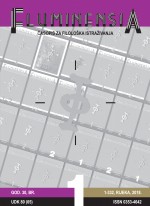HE SOUL AND BODY DEBATE IN THE CROATIAN GLAGOLITIC OXFORD MISCELLANY
Keywords:
Vision of St Bernard, contrasts/debates, Croatian Glagolitic literature, polyfunctionality, repentanceAbstract
The paper considers some contemplative aspects of the Croatian Glagolitic prose text The Vision of St. Bernard. It originates from one of the potentially most popular Latin contrasts, and is preserved in two Croatian Glagolitic miscellanies from the 15th century. It mirrors general aspects of the medieval Christian spirituality and is draped in a vibrant, dramatic dialogue. Although the fate of the protagonists (agonists, in fact) is known in advance, their argument is marked by stylistically successful variations of the teaching essentially addressing the receivers. The version of the work recorded in the “Oxford Miscellany” (Oxford, Bodleian Library, Ms. Can. Lit. 414) includes a dream vision (assigned to one of the most important medieval theologians and thinkers, St. Bernard of Clairvaux); at the end, the narrating author, in a manner typical of Croatian Glagolitic texts, directly addresses the audience with his lesson and a call to repentance. Similarly to other preserved Croatian medieval works of religious content, this work is also multi-functional: in addition to its aesthetic qualities, it also has a clear edifying character. The text is largely composed as a dramatic debate/contrast between the soul and the body of a dying sinner, engaged in a mutually accusatory debate as the soul is condemned to an ever-burning hell. The contrast includes a lot of emotions; the soul’s part reflects all the sins committed by the dying man. The soul is engaged in self-pity and lamentation, without showing any sense of guilt or remorse. To that extent, this work serves as a mirror for the audience – they can recognize what they are like and what they should be like through the wording of the dialogue (which also has some features of performability), with its underlying message being a call to repentance.

